The Terracotta Army (兵马俑), also known as the Terracotta Warriors, is a collection of thousands of life-size ceramic statues representing soldiers, horses, chariots, and other military figures that were buried with the first emperor of China, Qin Shi Huang, in 210-209 BCE. They were discovered in 1974 by a group of farmers who were digging a well in Lintong District, Xi’an, Shaanxi province, China.
The army of terracotta warriors is considered one of the most remarkable archaeological discoveries of the 20th century and has been a UNESCO World Heritage Site since 1987. The warriors were created to accompany Qin Shi Huang in the afterlife, and their production involved a massive workforce of artisans and laborers. Each figure is unique, with different facial expressions, hairstyles, and clothing, reflecting the diversity of the ancient Chinese army.
The terracotta warriors are organized in battle formations, and their impressive size, attention to detail, and historical significance make them a popular tourist attraction in China. They provide valuable insights into ancient Chinese military tactics, weapons, and culture and have also been used to study the evolution of ceramic technology in ancient China.
Today, the Terracotta Warriors and Horses Museum in Xi’an displays the largest group of the terracotta army, with over 8,000 soldiers, 130 chariots, and 670 horses, and it continues to attract millions of visitors every year.
Table of Contents
- Basic Information
- Location and Transportation
- Three Pits of the Terracotta Warriors
- Different Kinds of Terracotta Warriors
- Vlog about Terracotta Warriors
- Recommended Route
- Useful Tour Tips
- Interesting Facts
Basic Information
| Website | http://www.bmy.com.cn/ |
| Estimated length of tour | 2 -3 hours |
| Ticket Price | Adults: 120 RMB (1 adult can bring 3 children under 16 years old for free) |
| Opening Hours | 8.30 – 17.00 (March 16th – November 15th) 8.30 – 16.30 (November 16th – March 15th the next year) |
| Telephone Number | 0086-029-813912829 |
Location and Transportation
The museum of Terracotta Warriors and Horses is located in the suburb of Xi’an. The specific address is Qinling North Road, Lintong District, Xi’an. It was built near the site of the original discovery to protect and preserve the delicate terracotta sculptures. Because of its relatively remote location, you can only get there by bus.
There are three express buses to the museum. They set off every half an hour from Qinfeng Station (秦风发车场), Great Wild Goose Pagoda (Dayanta 大雁塔), and Drum Tower (Gulou 鼓楼). The one-way ticket costs 30 RMB and the return ticket costs 60 RMB without a discount. The operating time is from 8.00 to 13.00, and the last return from the tourist spot is at 16.00.
Or you can take bus 305 or tourist line 5 on the opposite side of the train station. It leaves every 10 minutes and costs 8 yuan to and 10 yuan back. However, it does take longer than the express buses.
Three Pits of the Terracotta Warriors
The First Pit of the Terracotta Warriors

The First Pit of the Terracotta Warriors, located in the south, is an impressive archaeological site measuring 230 meters in length from east to west and 62 meters in width, covering an area of 14,260 square meters. At the eastern end of the pit, there are 210 warrior statues dressed in full armor, organized in rows of 68 figures each, forming a rear guard phalanx. The central part of the pit features 38 rows of chariots and infantry, representing the main body of the army.
From 2009 to 2022, the Museum of the Terracotta Warriors conducted the third formal excavation of the First Pit. During this excavation, over 220 terracotta figures were unearthed. These figures have been categorized based on their headgear, armor, and attire into senior military officer figures, mid-level military officer figures, junior military officer figures, and general warrior figures. Preliminary analysis and research have further subdivided the junior military officer figures into two distinct types.
Archaeologists also discovered remnants of Qin dynasty shields. These shields are similar in shape to those found on the bronze chariots but are twice the size. This is the first discovery of Qin shields in the archaeology of the Qin Mausoleum. Additionally, bronze long swords and crossbows were unearthed, providing the first clear identification of “qingmu” (a type of wood) and the preservation methods for crossbows.
The Second Pit of the Terracotta Warriors
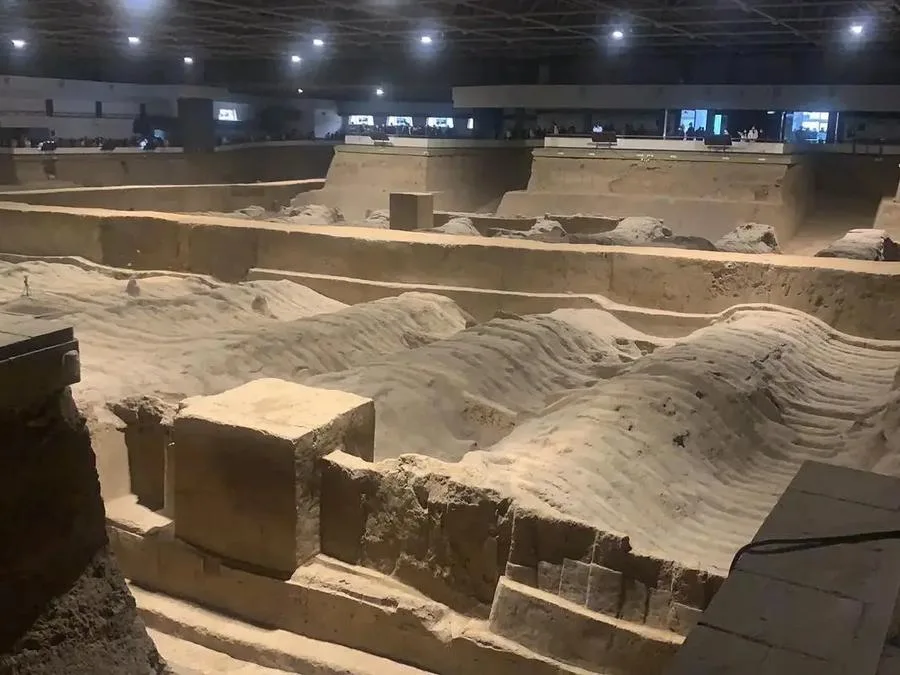
Located to the northeast of the First Pit and east of the Third Pit, the Second Pit is a remarkable archaeological site in its own right. Measuring 96 meters in length from east to west and 84 meters in width from north to south, it covers a total area of approximately 6,000 square meters. Similar in structure to the First Pit, the Second Pit is notable for its more complex and comprehensive military formations, making it the most spectacular of the three pits.
The Second Pit features a multi-unit special force composed of cavalry, chariots, and infantry, including crossbowmen. Within this pit, over 1,300 terracotta figures and horses, more than 80 chariots, and tens of thousands of bronze weapons have been discovered. Notably, it includes figures of generals, saddled horses, and kneeling archers, all found here for the first time. The pit is divided into four main sections:
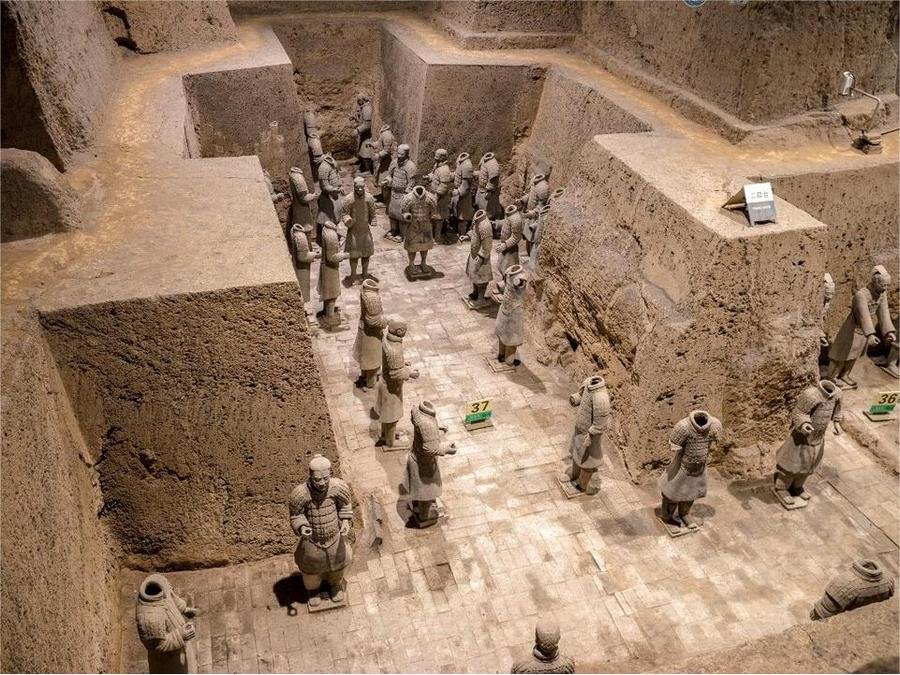
- The First Unit:
- Located at the eastern end of the pit.
- Features a long corridor with 60 standing crossbowmen surrounding the unit.
- The core consists of 160 kneeling crossbowmen arranged in eight rows facing east.
- The formation is designed for rotational shooting to overcome the slow reload time of crossbows, with standing and kneeling archers alternating their fire.
- The Second Unit:
- Situated on the right side of the pit.
- Comprises a square formation of 64 chariots, each originally made of wood, with only the remnants remaining.
- Each chariot is drawn by four terracotta horses and followed by three soldiers: the driver in the center and two soldiers on either side, armed with long-handled weapons.
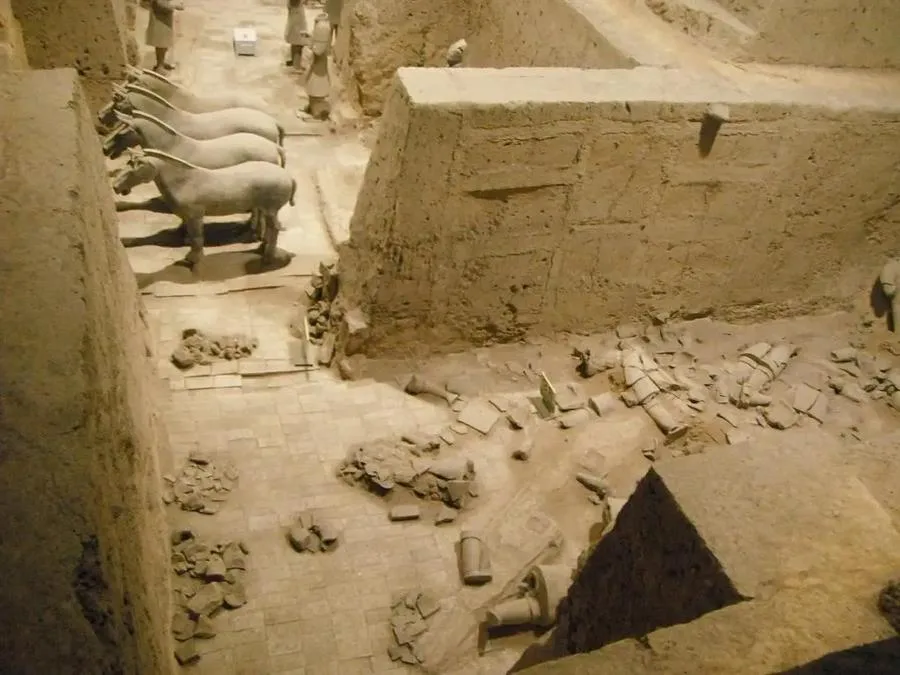
- The Third Unit:
- Found in the central part of the pit.
- Consists of 19 chariots, 264 infantry figures, and 8 cavalry figures arranged in a rectangular formation.
- Each cavalry horse is accompanied by a rider holding the reins in one hand and preparing to shoot a bow with the other.
- Behind each chariot are three soldiers and additional infantry ranging from 8 to 36 figures.
- The Fourth Unit:
- Positioned on the left side of the formation.
- Contains 108 cavalry figures and 180 saddled horses arranged in 11 rows.
- The first and third rows include six chariots each.
- Each horse is accompanied by a rider wearing a distinctive “barbarian” style outfit, holding the reins in the right hand and a bow in the left.
The Third Pit of the Terracotta Warriors
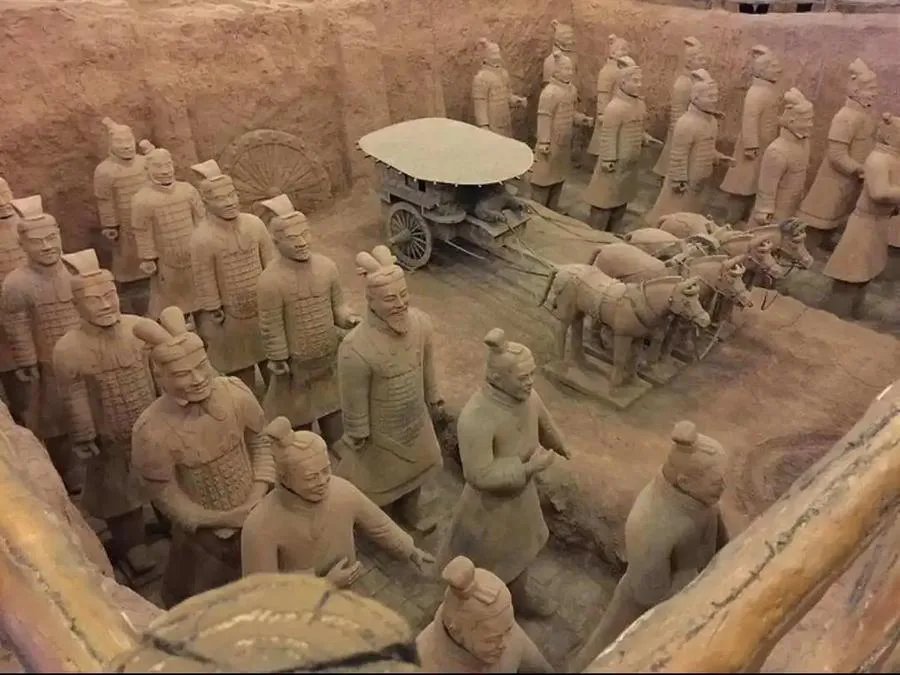
The Third Pit of the Terracotta Warriors, covering an area of approximately 520 square meters, is an intriguing and significant archaeological site. Located to the north of the western end of the First Pit and directly opposite the Second Pit, it is unique in its shape, resembling the Chinese character “凹” (āo), and consists of southern and northern chambers, as well as a central carriage chamber that houses a chariot pulled by four horses and four terracotta warriors. In total, the Third Pit contains around 68 terracotta figures.
What sets the Third Pit apart from the other two is its role and preservation state. Unlike the First and Second Pits, which suffered damage from fires, the Third Pit remains relatively intact, with many of the terracotta figures retaining their original paint. This has allowed researchers to study the vivid colors that once adorned these ancient warriors.

The layout and artifacts of the Third Pit suggest that it served as the command center for the armies represented in the First and Second Pits. This theory is supported by the pit’s central location among the three and its unique structure. The presence of only a small number of warriors, along with a chariot, indicates a strategic, rather than combative, purpose.
Historically, during the Spring and Autumn Period and the Warring States Period, military commanders often led from the front lines. However, as warfare evolved and became more complex, the Qin Dynasty developed more sophisticated tactics. By the time of the First Emperor, command structures had advanced significantly. The Third Pit illustrates this progression, representing one of the earliest known military command centers in archaeological history.
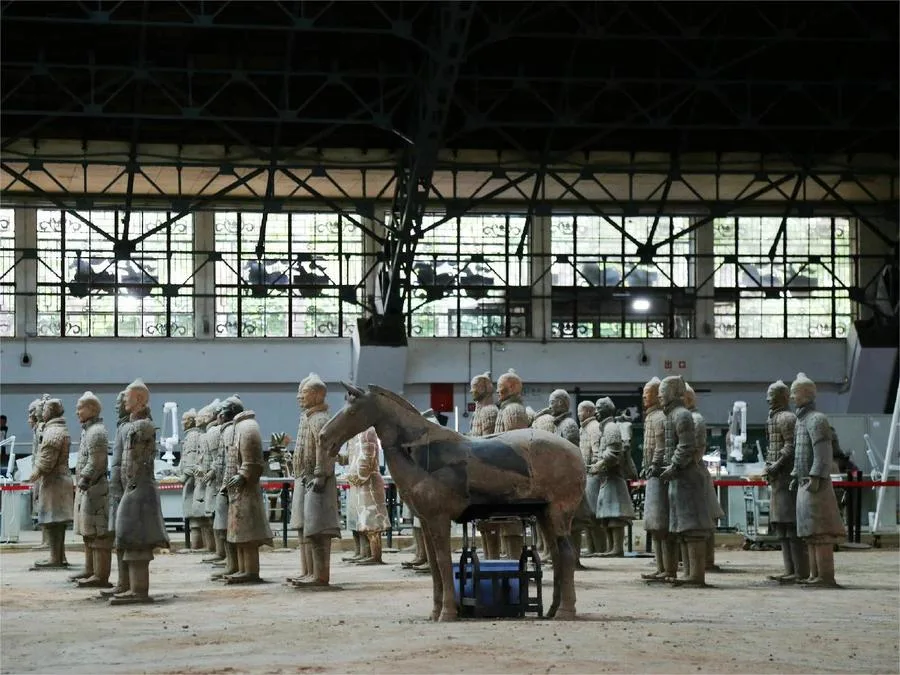
The separation of the command unit from the main army allowed for more strategic planning and improved the safety of high-ranking officers. This separation marked a significant development in military tactics, highlighting the maturation of ancient Chinese warfare strategies.
Archaeologically, the Third Pit is a treasure trove of information. Its well-preserved state provides valuable insights into the construction techniques, layout, and operational strategies of a Qin Dynasty military command post. The terracotta figures, chariots, and weapons found within offer detailed evidence of the period’s military uniforms, ceremonial practices, and command systems.
Different Kinds of Terracotta Warriors
The Terracotta Warriors can be broadly classified into two main categories: soldiers and military officers. Among the officers, there are three ranks: junior, middle, and senior. Soldiers are generally depicted without headgear, while officers wear crowns, with different styles distinguishing ordinary officers from generals.
Warriors on Chariots (车兵俑)
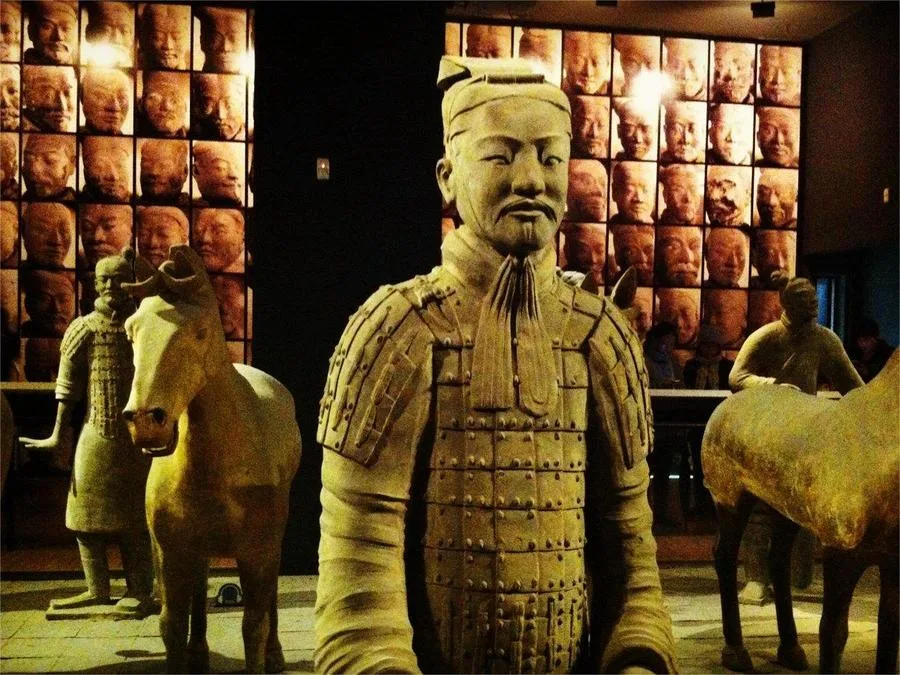
Warriors on Charioteer, also known as “Cheshi” in Chinese, were soldiers positioned on war chariots alongside the charioteer. Typically, each chariot would have two warriors, known as the left and right charioteers. The left charioteer wore long robes and draped himself in armor, wearing leg guards and a headpiece. He held long weapons like spears, halberds, or tridents in his left hand while bracing himself against the chariot with his right hand. The right charioteer had the same attire as the left one but with reversed positioning. These warriors played a crucial role in chariot warfare, though historical texts suggest differences in their weapon configurations and combat responsibilities.
Standing Archer Warriors (立射俑)

Standing archer warriors are a distinctive type found in the Terracotta Army, primarily unearthed in the eastern part of Pit 2. Armed with bows and crossbows, they formed the front part of the crossbowmen units. These warriors are depicted wearing lightweight battle robes, tied with leather belts, and adorned with a high topknot hairstyle. Their footwear consisted of pointed-toe shoes, providing agility on the battlefield. The stance of these archer warriors aligns with ancient texts describing archery techniques, indicating the advanced level of archery skills during the Qin Dynasty. Their gestures, as recorded in historical texts, demonstrate the standardized shooting techniques developed during the reign of Emperor Qin Shi Huang, serving as a model for archery practices in later periods.
Kneeling Archer Warriors (跪射俑)

Kneeling archer warriors, unearthed alongside standing archer warriors in the eastern part of Pit 2, formed part of the crossbowmen units. While standing archers were positioned at the front of the formation, kneeling archers were stationed at the heart of the military array. These warriors wore battle robes draped with armor and sported a distinctive hairstyle with a topknot on the left side. Their footwear, depicted with meticulous detail, showcased the craftsmanship of the artisans, reflecting a commitment to realism. Kneeling on their right knee with the left leg bent, they held a bow in a poised position, capturing the essence of individual archery practice. Notably, remnants of red pigment on their armor highlight the exquisite preservation of these unique figures, providing valuable insights into ancient Qin military attire and practices.
Infantry Warriors (武士俑)
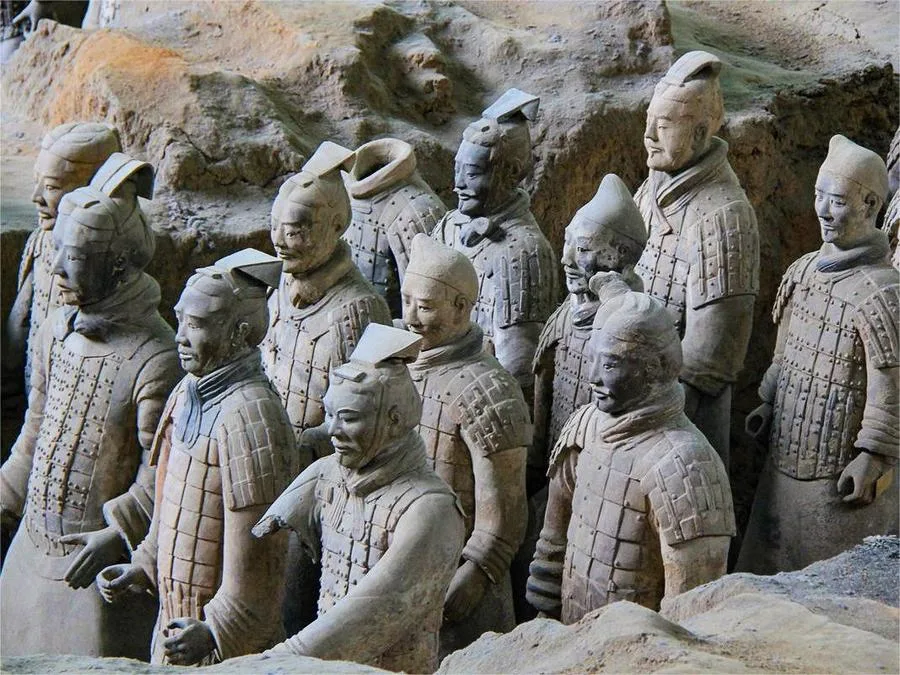
Infantry warriors, representing the bulk of the Terracotta Army, were the ordinary foot soldiers with an average height of around 1.8 meters. These warriors formed the backbone of the military formation and were divided into two main categories based on their attire: robe-wearing warriors and armored warriors. Robe-wearing warriors, characterized by their flexibility and agility, were predominantly positioned at the forefront of the formation. On the other hand, armored warriors were distributed within the formation, showcasing a more robust defense. Both types of warriors wielded real weapons, exuding a sense of vigor and readiness even in their static terracotta forms.
Military Officer Warriors (军吏俑)
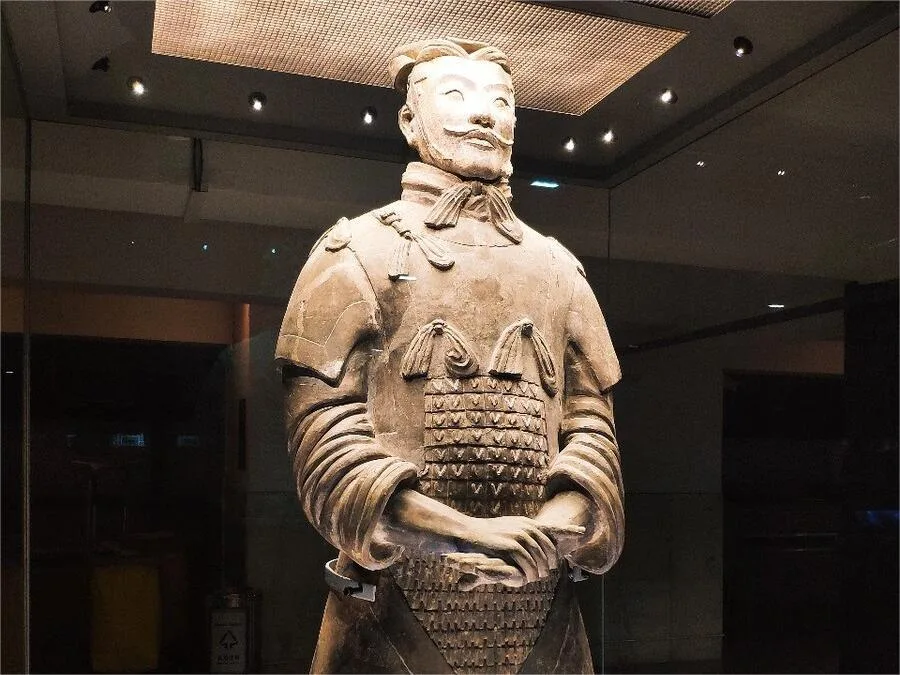
Military officer warriors, ranking below general warriors, are classified into middle-ranking and lower-ranking categories. Their representation in the pits is minimal, with fewer than ten specimens unearthed. They are further categorized into robe-wearing generals and armored generals. Armored generals typically don double or single-layered long crowns and wear various styles of armored robes. Adorned with intricate decorations such as colorful floral knots on the chest, back, and shoulders, these warriors exude magnificence and authority, symbolizing their rank and status within the military hierarchy. In contrast to generals, military officer warriors exhibit slight differences in both attire and demeanor. While they may not possess the robust physique of generals, they stand tall with broad shoulders and solemn expressions, reflecting their thoughtful and martial nature, some displaying homesickness.
Cavalry Warriors (骑兵俑)

Cavalry warriors, totaling 116 specimens unearthed from Pits 1 and 2, were primarily utilized for swift maneuvers during wartime. Distinguished by their specialized role, cavalry warriors don attire distinct from infantry and chariot warriors. Adorning round caps and tight-sleeved jackets with overlapping right flaps secured at the chest, they wear snug trousers and short boots, complemented by small-scale armor. Unlike infantry and chariot warriors, cavalry warriors lack shoulder pads and armguards, emphasizing agility over heavy protection. Their compact attire facilitates swift movement, with one hand gripping the reins while the other wields a bow. This specialized attire underscores the agility required for ancient cavalry tactics. The discovery of cavalry warriors in Pit 2 represents the earliest physical evidence of cavalry in Chinese archaeology, providing invaluable insights into the attire and equipment of ancient cavalrymen.
Charioteer Warriors (驭手俑)
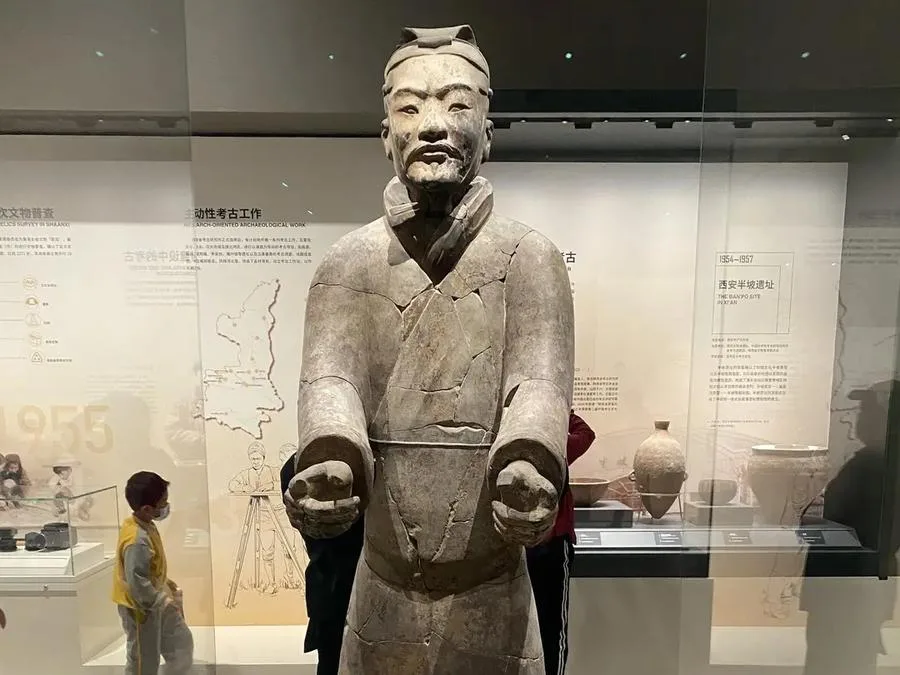
Charioteer warriors, tasked with driving chariots, are found in all three pits of the terracotta army. Adorned in long robes and armored with chest and arm guards, they wear leg protection and neck armor. Their heads are covered with cloth turbans and long crowns, and their arms are extended forward in a gesture of holding reins. In ancient warfare, chariots were formidable weapons, and the role of charioteers was crucial, often directly impacting the outcome of battles.
Chariot Horses (车马)
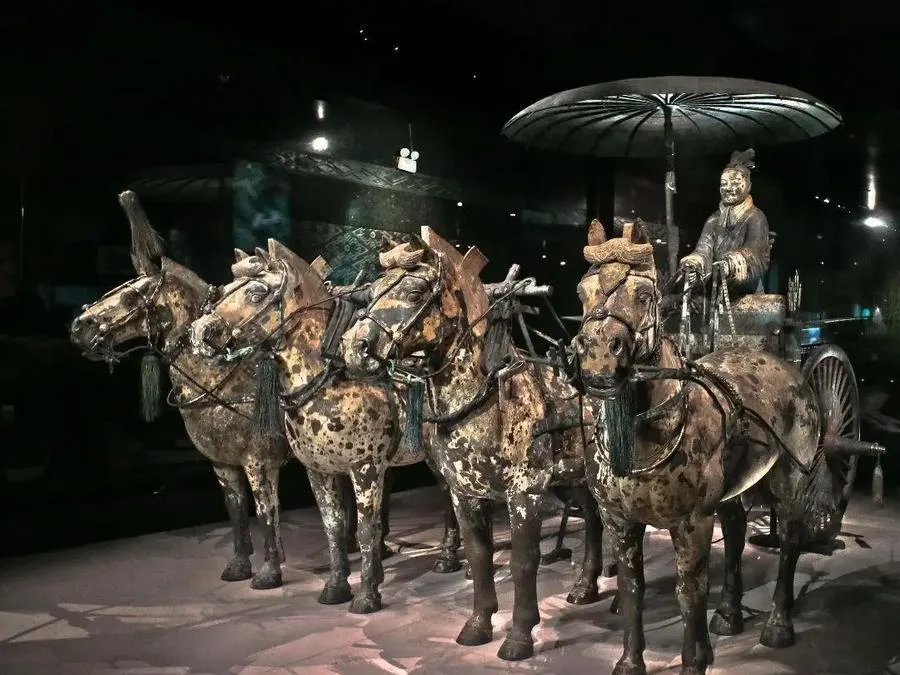
Each chariot in the terracotta army is led by four terracotta horses. These horses closely resemble real horses in size, with a length of about 2.10 meters and a height of 1.72 meters. The sculptures depict them with clipped manes, bound tails, raised necks, and open mouths, giving them an appearance of neighing. The two horses in the center have ears pricked forward and eyes looking straight ahead, while the outer horses have slightly turned necks, as if eager to move forward.
The terracotta horses unearthed from the pits closely match the proportions and characteristics of real horses found in the stables of Emperor Qin’s mausoleum complex. This indicates that they were sculpted based on real horses, likely reflecting the horse-breeding practices of the Qin Dynasty.
Saddled Horses (鞍马)
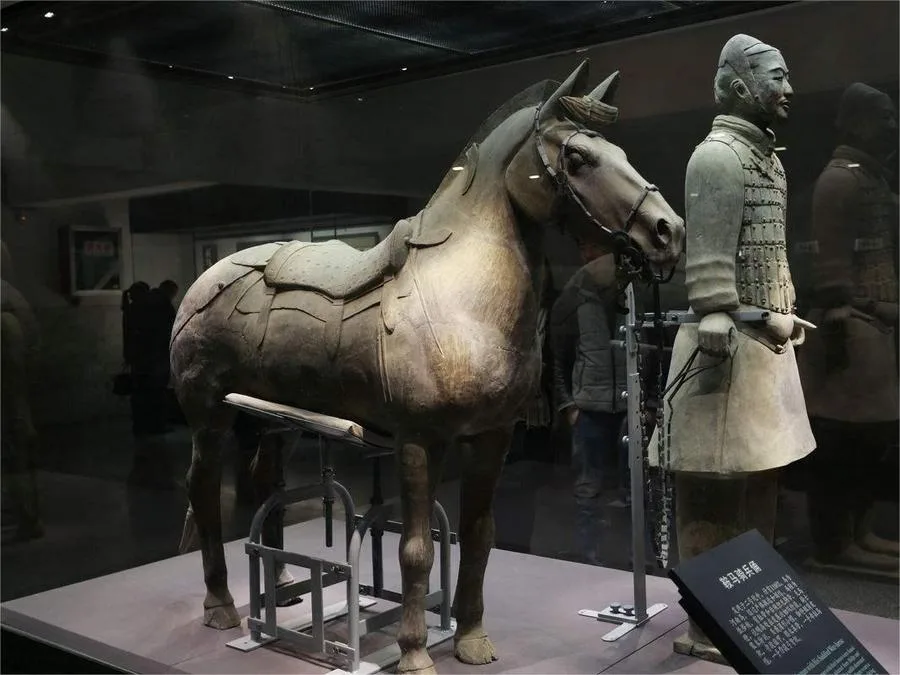
Unearthed from Pit 2, these terracotta horses stand at a height of approximately 1.72 meters. Observing their physical features, these terracotta horses have small heads, prominent noses, short and thick necks, low manes, broad backs slightly concaved downwards, and well-developed limbs. They represent a type of horse known for its combination of strength and speed, making them suitable for both pulling carriages and riding.
Historical records from the Qin dynasty, such as the Yumeng Qin Bamboo Slips, indicate that saddled horses were primarily sourced from government stables. County officials were responsible for managing the selection and training of military horses, directly influencing the quality of these horses. The Qin Dynasty was renowned for its horse-breeding capabilities, with both central and local government establishments maintaining stables to provide horses for cavalry and chariots.
Vlog about Terracotta Warriors
Recommended Route
Morning: Start your day naturally and take the subway to Huaqing Palace for a visit (optional). Afterward, take a taxi to the Lishan Garden Visitor Center.
At Lishan Garden Visitor Center: Purchase tickets for the electric shuttle bus and follow the route map to visit Pit 9901 (a part of the Terracotta Army, showcasing the organization and equipment of the Qin Dynasty army), the bronze chariots and horses, and Pit 0006 (famous for its precious artifacts).
After the Visit: Take the free shuttle bus to the Terracotta Army site for further exploration. You can visit the pits in the order of 1, 2, 3 or 2, 1, 3 depending on the crowd flow.
Return: After your visit, take a bus across the street from the exit to Huaqing Pool Metro Station. Finally, take the subway back to the city center.
Useful Tour Tips
1. Bus. Bus No. 306 or Tourist Line 5 at Xi’an Train Station leads to the museum of Terracotta Warriors and Horses. But there are fake buses even in the station. You should pay attention to the clothes of the workers. The real workers wear blue uniforms and will not greet you with enthusiasm because of the heavy workload.
2. Tourist guide. Many tourist guides are peddling at the gate of the museum. Most of them have certifications and are professional. If you want a detailed introduction and better learn about the terracotta army, you may hire one there (cost about 120 RMB).
3. Stay away during holidays. As one of the most famous tourist attractions in China, the Musem of Qin Terracotta Warriors and Horses is swamped by visitors during public holidays. You can barely see anything but heads and shoulders.
4. Souvenirs. The souvenirs sold in the museum are generally overpriced. You can find better and cheaper ones in the city.












I found it quite easy to buy tickets today, so I thought there wouldn’t be many people.
I arrived at Lishan Garden at noon and there weren’t many visitors. However, when I got to the Terracotta Warriors around 1:30 PM, it was still pretty crowded. After exploring the site, I came out around 3 PM, and there was hardly anyone going in. It was truly an impressive experience, although my legs were sore from walking so much!
On the morning of April 20th, around 8:15 AM, the Terracotta Warriors were already overcrowded. Many people rushed in as soon as the doors opened, so everyone should be careful and stay safe.
The No. 1 Pit of the Terracotta Army is indeed the most crowded pit. However, the taxi driver mentioned that it’s actually less crowded today; on Thursday morning at 6 a.m., the entrance was packed with people.
Although it is the off-season, there were still quite a few people. The guides in the museum gave excellent explanations. However, the journey is a bit long, and with the visiting time and travel, it takes about four to five hours.
We arrived early at 5:17 AM, making it in time for the first batch of visitors when the museum opened. There were very few people. We hired a guide, and the kids listened attentively. When we came out, a large tour group had arrived, and it was quite crowded.